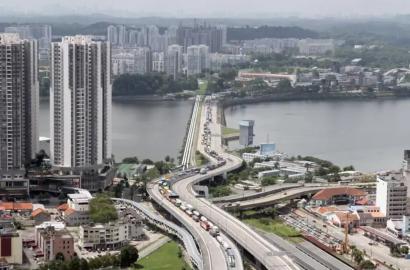Explore Our Exciting New Property Listings Now Available in Prime Locations!
The Johor Bahru property market is on a positive growth trajectory, driven by new project announcements and government initiatives throughout the year, says Olive Tree Property Consultants (Johor) Sdn Bhd CEO Samuel Tan when presenting The Edge Malaysia | Olive Tree Property Consultants Johor Bahru Housing Property Monitor 4Q2024.
The announcements include the launch of the highly anticipated Johor-Singapore Special Economic Zone (JS-SEZ); a potential light rail transit (LRT) line or an autonomous rapid transit (ART) in Johor Bahru and its surrounding districts; and the conversion of private lease scheme units (PLS) to freehold status for Medini Iskandar Malaysia projects.
For the past 50 years, PETRONAS has been at the forefront of the energy sector, pioneering innovation and driving industry transformation. Recognising that the transition to a sustainable, low-carbon energy future is not just an environmental necessity but also a socio-economic imperative, PETRONAS balances meeting global energy demands with championing a just and equitable transition for all. This recent collaborative initiative with United Kingdom-based Energy Institute (EI) signifies the company’s commitment to a sustainable future.
In providing more information on the recent launch of the JS-SEZ, Tan says: “Malaysia and Singapore officially launched the JS-SEZ with an ambitious target of attracting 100 projects in 10 years. It now covers Iskandar Malaysia, Forest City, Pengerang Integrated Petroleum Complex and Desaru.
“The scopes have been expanded to new priority sectors such as aerospace, electrical and electronics, chemical, medical devices and pharmaceuticals. These are in addition to other sectors such as business services, the digital economy, healthcare, manufacturing, tourism, education, logistics, energy and food security.”
He explains that the JS-SEZ will be operated on a project-by-project basis, where infrastructure will be built as projects, and investments are agreed upon, as opposed to the conventional arrangement of building infrastructure before attracting investments.
There are also special incentives for companies investing in new qualifying manufacturing and services such as artificial intelligence and quantum computing supply chain, medical devices, aerospace manufacturing and global services hubs. These companies will enjoy a special tax rate of 5% for up to 15 years. Besides that, eligible knowledge workers working in JS-SEZ are entitled to a special tax rate of 15% for 10 years.
“This is a step closer to the actual implementation of the ambitious cross-nation initiative,” Tan opines.
However, he says, it was reported that some Singapore manufacturing firms have concerns over the execution of the project-by-project model and whether infrastructure can be completed on time.
“The authorities and the private sector need to have regular dialogues and consultations to ensure timely infrastructure deliverables to match projects’ demand. This approach will benefit established destinations with major infrastructure works — such as road, power, water and internet coverage — ready.
“The tax incentives for qualified companies and individuals are welcomed. Nevertheless, most companies and workers are monitoring closely the actual implementation and the ease to qualify for the tax incentives. In addition, we believe multinational corporations (MNCs) will be looking for more than just tax incentives. Green technology, knowledge and capital-intensive MNCs would probably expect relocation incentives and other special concessions,” Tan elaborates.
Although the Kuala Lumpur–Singapore high-speed rail (HSR) is not included as part of the JS-SEZ initiative at this juncture, Tan is optimistic that such a long-term project would eventually be reconsidered in the future.
“This is especially so when JS-SEZ is successful and such a model is replicated in other parts of Malaysia. There would be more justification for an efficient high-speed rail serving as another spine connecting the nation,” he adds.
Potential market drivers
To further propel Johor Bahru’s property market, Iskandar Investment Bhd, the landowner of Medini Iskandar Malaysia in Johor Bahru, announced plans to extend the option of converting properties under the private lease scheme to freehold. This will be applicable to developers buying vacant land or individual buyers of completed projects.
An earlier report by The Edge Malaysia titled “The end of private lease scheme in Medini?” states that existing registered developers in Medini, for example, have the option to acquire a freehold interest in their land bank from Iskandar Investment, specifically for undeveloped land.
“This is definitely good news for existing property owners and future buyers. With its lease perpetuity and the willingness of banks to finance the resale property, a converted freehold status to the title will increase property resale values. We are given to understand that the premium payable will be nominal for completed units, where serviced apartments will be charged a premium of RM5,000 and RM8,000 for units of less than 1,000 sq ft and above 1,000 sq ft respectively,” Tan says.
“All owners would want to convert their titles to that of freehold. We expect Medini will become a sought-after location again. With its strategic location, good connectivity and excellent infrastructure, developers will be keen to develop and invest in the location again, especially with the JS-SEZ and Forest City Special Financial Zone in the grand scheme of the plan to revitalise Johor Bahru. The market will be watching closely the official announcement on the implementation of such a lease conversion.”
He hopes the administration process of the lease conversion will be simplified.
Elsewhere, in a move to alleviate traffic congestion once the Johor Bahru-Singapore Rapid Transit System (RTS) Link is completed, the federal government has proposed to build an LRT line or an ART tram-bus network in the city and its surrounding areas. Recent news reports have said the two networks could cost RM20 billion and RM7 billion respectively.
Tan welcomes these proposals. “The Johor-Singapore Causeway is one of the world’s busiest land crossings. As at March 2024, 430,000 to 450,000 people use it daily, based on data from Johor Immigration. The figure has exceeded the 400,000 average recorded in 2019, prior to the pandemic. It is therefore important to resolve the potential congestion problem around the RTS terminal when the RTS Link starts operations in about three years.”
However, there are challenges to executing such mega projects, he cautions. “Firstly, private funding will be needed. The details of the funding mechanism, land acquisition, project feasibility relative to the fares, government concession and other operational issues will take time to sort out.
“Secondly, it is not easy to change the habits and mindsets of Malaysians to pivot to public transport. The public transport network needs to be very efficient to encourage the locals to use it. Such an extensive network needs time to develop. Low utilisation of LRT or ART especially during the initial period makes the projects’ viability challenging.
“Nevertheless, we are hopeful that a good public transport system linking various regions within Johor Bahru via LRT or ART and RTS Link will be a transformative move for the economic development of the city in the long term,” Tan adds.
Although things are now looking up for Johor Bahru, he is worried that US President Donald Trump’s expanding of protectionism and escalating of trade war could affect global supply chains, including Malaysia.
“Trump has been threatening to impose a 60% tariff on China’s export and a ‘modest’ universal tariff on all other countries. China has publicly declared that it will retaliate against the US tariff hike while Europe, Canada and Mexico have also expressed their resolve to oppose the US. A prolonged trade war would slow global economic growth, reducing demand for Malaysian exports, especially commodities like palm oil, rubber and natural gas.
“On a brighter note for Asean countries, Malaysia might attract more investment under the China+1 strategy adopted by these companies to avoid tariffs. This was evident during the previous US-China trade war when Southeast Asia, including Malaysia, saw increased foreign direct investment. We assess that the net effect of Trump’s second term is likely to spark more surprises and uncertainties to the already fragile global political and economic landscape,” Tan adds.

Related posts:
“A vacancy tax typically applies to properties that remain vacant — unsold or unrented — for more than six months in a year. In countries such as Canada and Australia, particularly in cities like Melbourne, this tax is set at...
Johor Bahru property prices registered a sharp increase in the second quarter of 2025 following the launch of the Johor-Singapore special economic zone (JS-SEZ), driven by strong demand for high-end housing and cross-border investor interest.


